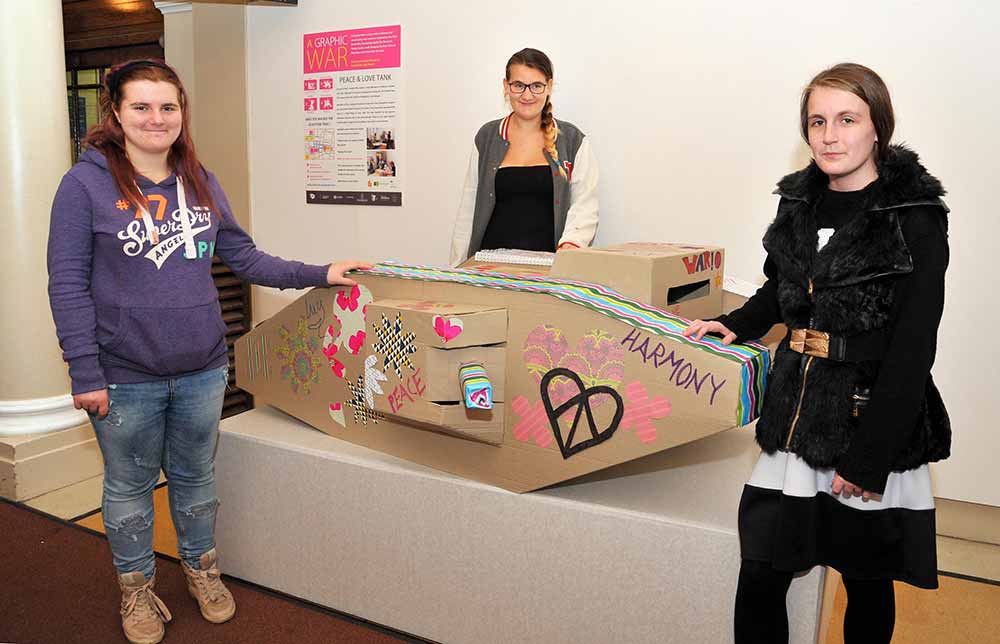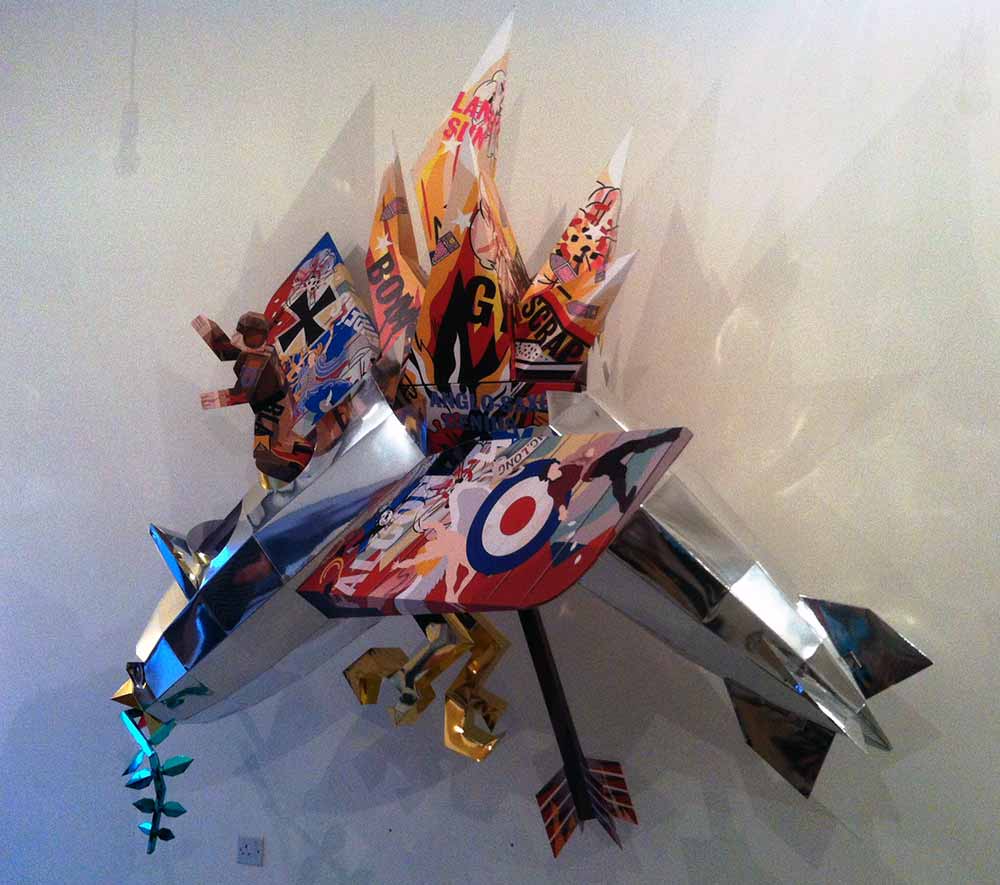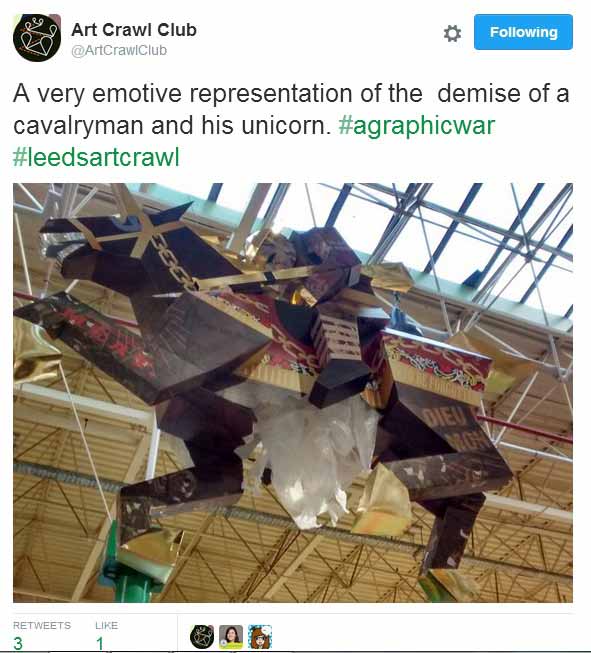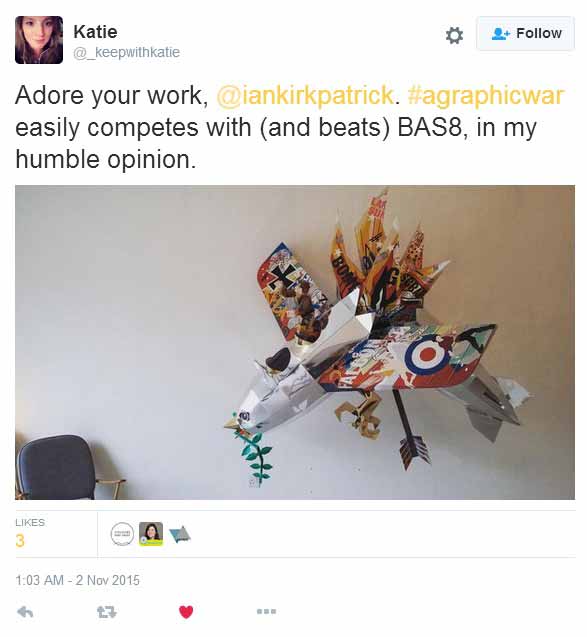A Graphic War began life as a conversation between Ian Kirkpatrick and myself. We discussed how we might investigate graphic design in the First World War in a creative and engaging way.
Our plans were realised when Ian was able to become of the Leverhulme Trust’s Artists-in-Residence, funding a trail of sculptures around Leeds City Centre. We wanted people to encounter contemporary art and the First World War in new spaces and places and to take the collections outside the museum.
- Tweet about A Graphic War
- Tweet about A Graphic War
By putting art inspired by the museum collection right at the centre of life in Leeds, we hoped to reach new audiences. We wanted to create eye-catching works that allowed viewers to peel back layers of meaning, or just enjoy in their own right.
In the time Ian’s residency allowed, we estimated that he could complete four sculptures – forming the basis of a trail, alongside community engagement work. We decided to display one sculpture at Leeds City Museum, to make the link to heritage explicit – but we then had to decide where else to show them across the city.
Ian’s artistic practice is inspired by contemporary packaging, so one of the first things we did was to approach three very different retail spaces in the city to act as hosts. Luckily for us they all agreed!
- Trinity Leeds – the newest and biggest shopping destination in the city in 2015
- Leeds Markets – an amazing Victorian covered market
- Colours May Vary – an independent retail space dedicated to art and design
These places all have very different audiences who could become part of the ‘A Graphic War’ family.
What would work where? How could Ian design and produce bespoke sculptures for these spaces? Would people ‘get’ his work? How do you hang a war horse from a roof? How do you hang a Zeppelin on a wall? These were just some of the questions that came up as we developed the pieces.

Britannia on display in Trinity Leeds
Neither were Ian and I working as a duo – we of course enlisted other people to work with us as part of the process. As Leeds City Museum we work with a group of young people called the Preservative Party, who are aged 14-23 and interested in museums and heritage. We really wanted to involve them in the process of input into an artistic project.
After chatting about the different themes to work with Ian on, the group chose the theme of women’s rights to research for Ian and to give him some curatorial advice! This led to the final form of the Britannia sculpture – inspired by Votes for Women and the massively important role that female munitions workers in Leeds had during the war.
Another organisation we were lucky to work with was The Cupboard, an organisation in Leeds dedicated to supporting young people in the city living complex lives. Ian and I led a six-week course with them, discussing First World War histories and propaganda and how they could link to Ian’s art. The group had a lot of freedom and chose to create their own sculpture, inspired by history and by Ian’s work.

Members of The Cupboard
The first two points on our trail were complete – BLAST and Britannia. Two more sculptures to go and, as visitors noticed, the tone altered.

Kingdom of Dreams on display in Leeds Kirkgate Market
The next location was Leeds Kirkgate Markets. After early conversations with the site team there, we realised whatever sculpture was produced would need to hang from the ceiling! One of themes we’d talked about together was the idea of disability and the war, for soldiers and the effect of the war on animals. Kingdom of Dreams makes this explicit – the colours darken, pain is visible in both the horse and the rider.
The last stop on the trail was Colours May Vary, whose flexible space allowed Ian to be more experimental with how we ‘floated’ the piece ‘Enemy of the Stars’ seemingly in mid-air. One of the earliest items Ian looked at was a series of postcards showing a Zeppelin being shot down, reflecting the way in which the First World War advanced air warfare forever.

Enemy of the Stars on display at Colours May Vary
With over one million visitors, great feedback and exciting follow-on projects, A Graphic War has been one of the most exciting projects I’ve worked on in my career. It’s wonderful that the sculptures are now together at The National Archives and I look forward to seeing them in other spaces and places in the future. Most importantly – what do you think?
A Graphic War: Sculptures by Ian Kirkpatrick will be on display at The National Archives until the end of April 2017.


